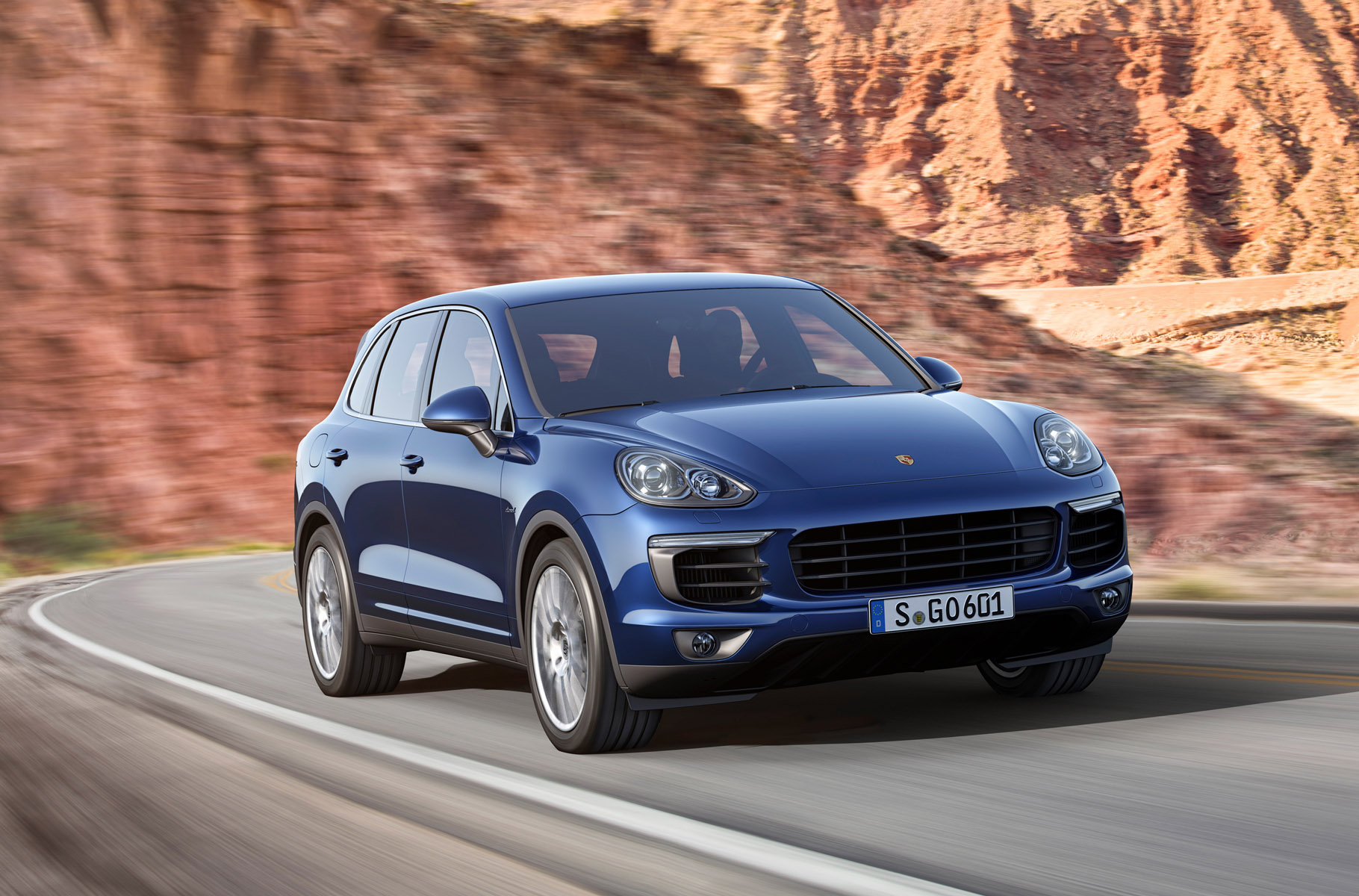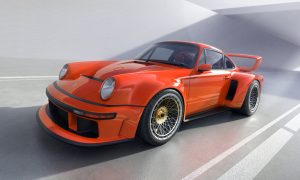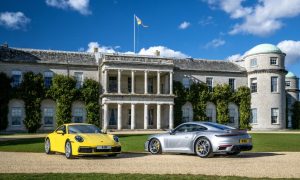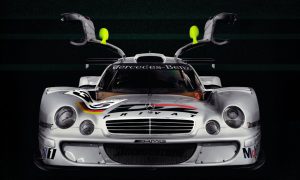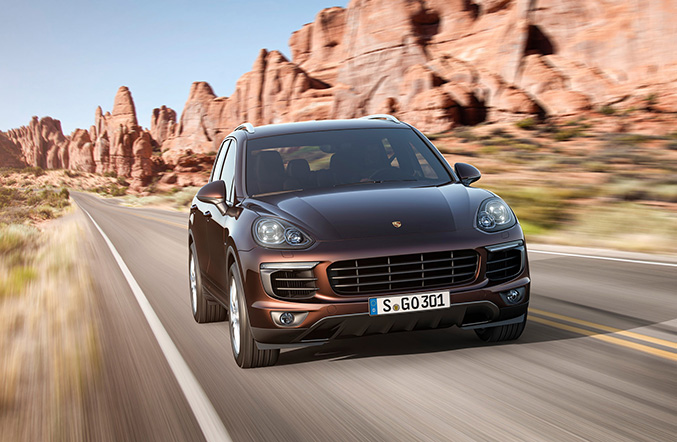 Porsche today announces the new generation of the Cayenne, the key characteristics of which include sharper design, boosted efficiency and an extensive breadth of standard features. As a sports car among sport utility vehicles (SUVs), besides offering five seats and extensive features, the Cayenne offers a lot of room for a lot of driving fun; combining high performance and typical Porsche design DNA.
Porsche today announces the new generation of the Cayenne, the key characteristics of which include sharper design, boosted efficiency and an extensive breadth of standard features. As a sports car among sport utility vehicles (SUVs), besides offering five seats and extensive features, the Cayenne offers a lot of room for a lot of driving fun; combining high performance and typical Porsche design DNA.
The Cayenne is a unique success story at Porsche. The company introduced the first generation in 2002, and made the idea of a sports car in the SUV segment a reality – and it set a new benchmark right from the start.
Sales have exceeded all expectations. Over 276,000 examples of the first generation Porsche Cayenne were produced (2002 to 2010), and around 303,000 units of the second generation, which was introduced in 2010, have been produced so far. Over this period, the Cayenne is not only boosting profitable growth at Porsche, it is also creating a solid economic foundation for investments in future generations of sports cars.
On sale now and arriving in Porsche Centres from 11 October, the new generation of the Cayenne will be launched in five versions: Cayenne Diesel, Cayenne S, Cayenne S Diesel and Cayenne Turbo. The highlight is the Cayenne S E-Hybrid, which makes its world premiere as the first plug-in hybrid in the premium SUV segment. This model, together with the Panamera S E-Hybrid and the 918 Spyder super sportscar, makes Porsche the world’s only car manufacturer to offer three plug-in hybrid models.
A further development is the new 3.6-litre V6 bi-turbo engine in the Cayenne S, that was fully developed by Porsche. Overall, every Cayenne powertrain shows improved performance figures as well as better fuel economy than equivalent previous versions.
Better efficiency
For Porsche engineers, boosting performance and efficiency are not incompatible nor contradictory goals. Numerous individual modifications to the entire drivetrain have enabled all new Cayenne models to consume significantly less fuel, not least courtesy of the further advanced ‘Auto Stop/Start Plus’ coasting function.
Optimised thermal management has taken another step forward, with active cooling air flaps being used for the first time on the Cayenne. Located behind the middle air inlet and controlled by the engine management, they open or close according to the specific driving situation and cooling needs; this way they adjust the air volume that is available for cooling. When they are closed, they improve aerodynamics which reduces air drag and thereby improves fuel economy.
The Cayenne S E-Hybrid is the first plug-in hybrid in the premium SUV segment. The technical progress made here is immense compared with the previous S Hybrid model. The new car features a lithium-ion traction battery with an energy capacity of 10.9 kWh, which enables an all-electric driving range of 18 to 36 km, depending on the style of driving and nature of the route.

The power of the electric motor is more than doubled from 47 hp (34 kW) to 95 hp (70 kW). The Combined fuel consumption is 83 mpg (79 g/km CO2). The three-litre V6 supercharged engine (333 hp / 245 kW) and the electric motor (95 hp / 70 kW) produce a combined system power of 416 hp (306 kW) at 5,500 rpm and a total system torque of 590 Newton metres from 1,250 to 4,000 rpm. This enables driving performance at the level of a sports coupé: zero to 62 mph in 5.9 seconds and a top speed of 151 mph. The top speed in all-electric driving is 77 mph. The traction battery can be charged from the electric power grid or while driving. Relevant vehicle data can also be called up from a smart phone using the standard Porsche Car Connect feature.
The hybrid tradition at Porsche extends back to 1899 and the Lohner Porsche – the world’s first vehicle to have battery-powered electric drive as well as a combustion engine, which was designed and built by Ferdinand Porsche. In the current model range, the Panamera S E-Hybrid is setting standards worldwide as the first plug-in vehicle in the premium class. The Cayenne S E-Hybrid is now transferring this forward-looking technology to the premium SUV segment. Extraordinarily powerful hybrid technology has also already been implemented in a sports car, and in a super sportscar no less – the Porsche 918 Spyder. This serves as an example of technology transfer from motorsport to production cars: the most advanced form of hybrid drive technology is deployed currently in the Porsche 919 Hybrid LMP1 Le Mans race car, and is also being studied for future production vehicles.
The new 3.6-litre V6 bi-turbo engine in the Cayenne S, which was developed entirely at Porsche, is another example of how downsizing with reduced engine displacement and fewer cylinders does not compromise core values: the engine’s NEDC fuel consumption is between 29.7 mpg and 28.8 mpg (223-229 g/km CO2), which is an improvement of over 2 mpg versus the previous V8 engine. The bi-turbo V6 develops maximum power of 420 hp (309 kW) at 6,000 rpm – a gain of 20 hp/15 kW. The engine torque of 550 Nm is available from 1,350 to 4,500 rpm (+ 50 Nm). The previous power density of 83 hp (61 kW) per litre has increased to 117 hp (86 kW) (+ 40 per cent). With its standard eight-speed Tiptronic S transmission, the Cayenne S accelerates from zero to 62 mph in just 5.5 seconds (5.4 seconds with the optional Sport Chrono package) – 0.4 seconds faster than the previous Cayenne S. Top speed is now 161 mph (an increase of one mph).
The Cayenne Turbo is characterised by its high level of spontaneous performance, searing acceleration and an ability to handle any driving situation. A 4.8-litre engine with eight-cylinders and twin turbochargers boosts engine power to 520 hp (382 kW) at 6,000 rpm, with torque of 750 Nm from 2,250 to 4,000 rpm. This lets the Cayenne Turbo accelerate from zero to 62 mph in just 4.5 seconds (4.4 seconds with the optional Sport Chrono package). Its top speed is 173 mph. Fuel consumption is 25.2 to 24.5 mpg (261-267 g/km CO2).
The diesel versions of the Cayenne combine sporting driving dynamics with even greater fuel efficiency. For example, the three-litre V6 engine in the Cayenne Diesel produces 262 hp (193 kW) at 4,000 rpm and has a fuel consumption of 42.8 to 41.5 mpg (173-179 g/km CO2). Thanks to its SCR combustion control system, the car already conforms to the EU6 emissions standard. Combined with its torque of 580 Nm, from 1,750 to 2,500 rpm, the car can accelerate from zero to 62 mph in 7.3 seconds (7.2 seconds with the optional Sport Chrono package), and its top speed is 137 mph.
The 4.2-litre V8 engine of the Cayenne S Diesel produces 385 hp (283 kW) at 3,750 rpm and awe-inspiring torque of 850 Newton metres from 2,000 to 2,750 rpm. From a standstill, it reaches 62 mph in 5.4 seconds (5.3 seconds with the optional Sport Chrono package). Its top speed is 156 mph, and its NEDC fuel consumption is 35.3 mpg (209 g/km CO2).
Chassis tuning of the new Cayenne has been optimised for even greater comfort, naturally without compromising dynamic pace. This makes the spread between comfort and sporting responsiveness even greater than before – and serves to emphasise the Cayenne claim to being the sports car in the SUV segment.
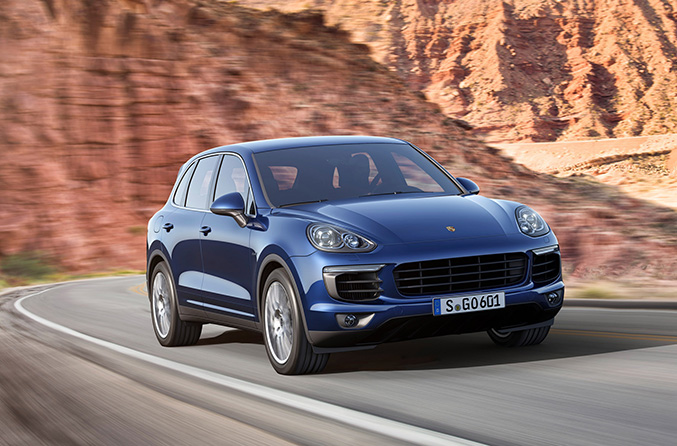
Sharpened exterior design
For the latest generation Cayenne, Porsche stylists have given the car an even sharper design with precise lines and purposefully-placed angles intended to catch the light. Entirely new are the design of the front body, the front wheel arches and the bonnet. Also new are the airblades in the nose; these air fins on the right and left of the front end are designed to efficiently guide air to the intercoolers, and also make a strong visual statement.
At first glance, the new Cayenne can be clearly identified by its bi-Xenon headlights, which are standard on Cayenne and S models, with characteristic four-point LED daytime running lights typical of Porsche. The distinctive appearance of the high performance standard bearer, the Cayenne Turbo, is further emphasised by LED headlights with the Porsche Dynamic Light System (PDLS) fitted as standard.
The rear of the new Cayenne also reflects this new styling treatment. The design of the rear lights creates a three-dimensional effect, and the brake lights – like the LED daytime running lights up front – feature four distinctive elements. The number plate recess, boot handle and lights are now integrated more elegantly into the tailgate. The designers also re-shaped the car’s horizontal lines, giving the vehicle an even fuller stance on the road. The newly-designed exhaust tailpipes are now integrated in the lower rear section. An automatically opening/closing tailgate is a standard feature.
Inside, the designers devoted much of their effort to the driving environment – the driver now gets a new multi-function sports steering wheel with gear shift paddles as standard; its look and operation is based on the steering wheel design of the 918 Spyder. The rear seating system has also been made more comfortable, and seat ventilation can now be ordered as an option.
New Porsche Cayenne in the UK
The new Cayenne models are on sale today, and will arrive in Porsche Centres in the UK and Ireland from 11 October. The new generation Cayenne range comprises:
- Cayenne Diesel – £49,902
- Cayenne S – £60,218
- Cayenne S Diesel – £61,474
- Cayenne S E-Hybrid – £61,474
- Cayenne Turbo – £93,763
Uniquely, the Cayenne S E-Hybrid is exactly the same price as that of the S Diesel, presenting customers with a clear choice depending on how they intend to use their car.
In tandem, effective immediately the price of the Panamera S E-Hybrid is being reduced by £4,926 to £84,401, an initiative made possible by synergistic effects realised by Porsche in the area of hybrid technology.
Standard equipment on all Cayenne models includes Porsche Traction Management all-wheel drive, Bi-xenon headlights with four point LED daytime running lights, multi-function sports steering wheel with paddle-shifts, ParkAssist front and rear, cruise control, automatic climate control, powered tailgate, Sport button, Start/Stop technology with coasting function and a three year warranty.
The Turbo adds LED headlights with Porsche Dynamic Lighting System, 19” alloy wheels, Porsche Active Suspension Management (PASM) with self-levelling air suspension, Porsche Communication Management with satellite navigation and BOSE Surround Sound audio.
Customers will also be able to explore the potential of their new Cayenne, and further develop their own skills behind the wheel, by participating in a complimentary course at the Porsche Experience Centre, Silverstone.
Source: Porsche
Previous article
VATH Mercedes-Benz A45 AMG
